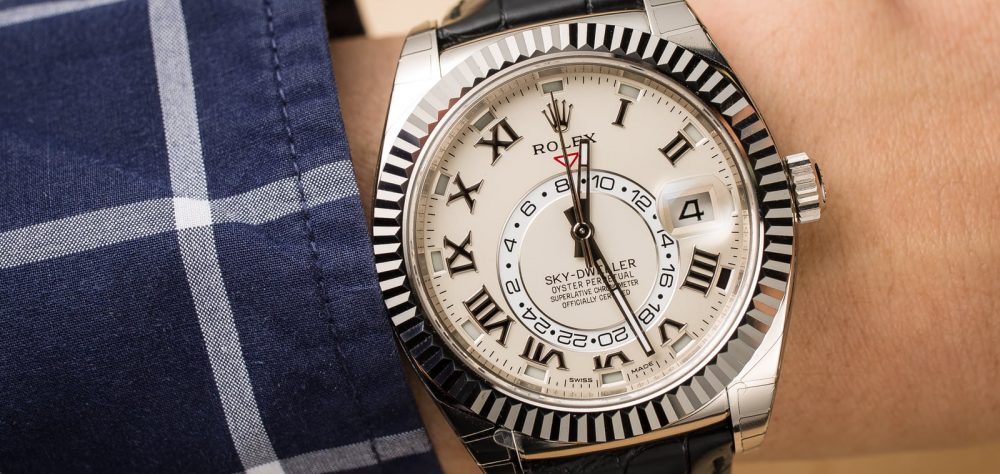
Rolex world headquarters, Geneva © Rolex/Cédric Widmer Replica Watches
Much to everyone’s surprise, Rolex Replica Watches has come out of its silence. The Geneva-based firm, which generally keeps a low profile, is still sparing with detail but in his first ever interview, Bertrand Gros nonetheless lifts a corner of the veil that shrouds the business. One way to keep the legend alive.
Does this chink in the armour signal a new trend in communication from the world’s biggest-grossing watch brand, which is owned by the Wilsdorf Foundation? In-house at least, the interview is seen as nothing short of revolutionary. Speaking to Swiss daily Le Temps, Chairman of the Board Bertrand Gros did, however, snuff out any hope that Rolex will be changing its corporate culture. The interview is, apparently, a one-off. “We have no obligation to become more transparent; nor do we feel the need to do so,” commented Mr Gros.
One of the main sentiments to transpire from the interview is the brand’s unshakeable confidence. Despite doubts raised in the press as to how well business is progressing, Rolex affirms that “all is for the best in the best of all possible worlds,” adding that 2013 was a record year during which the brand performed better than ever before, although no figures were forthcoming to substantiate this claim. The outlook is similarly positive, “not least given the highly favourable responses to the new products we presented at Baselworld,” commented Bertrand Gros, who rarely appears in public. With no means of verification, we shall have to take his word for it. Gros, a lawyer who is revered within the firm, repeatedly insisted on the brand’s excellent health. But on what grounds? Rolex’s transparency has its limits.
Caution in China

Rolex’s Chairman played down the impact of the Chinese government’s anti-corruption campaign. “We have always been very cautious in our expansion strategy for China. We believe the country has fabulous potential but one must be on the alert. This radical change in policy, which came about in just a few days, is the proof.” A sign of the times, over the first four months of the year, Swiss watch exports to China dropped 4.4% on 2013 and lost 27.6% compared with the previous year. Gros – whom staff address as Maître, the title given to attorneys in French-speaking countries – gave no quantifiable indications as to Rolex’s position in China.

Well, almost none. Bertrand Gros did lift a corner of the veil on one of Swiss watchmaking’s best-kept secrets, namely Rolex’s sales. Certain estimates, particularly those of Vontobel, were, he said, “fairly accurate.” The Zurich bank sets a figure of some CHF 4.6 billion, although Mr Gros did specify that these estimates “are based solely on Rolex’s exports to its subsidiaries, and therefore do not include sales made by them.” In other words, the brand’s global sales could be in excess of CHF 5 billion. Some analysts, on the other hand, consider this to be disproportionately high; they put the cursor around the CHF 3.5 billion mark. As for operating margin, Mr Gros commented that the suggested figure of 30% was “plausible”.
He went on to justify the firm’s legendary discretion. Unlike other Replica Watches Sales groups, which are publicly listed, Rolex is owned by a single, private shareholder, the Wilsdorf Foundation, and is therefore under no obligation to publish its results. “Rolex is accountable to no-one but its sole shareholder,” he declared. Point taken.
Four CEOs in six years
Rolex’s Chairman took this opportunity to say more about the appointment of Jean-Frédéric Dufour as the next CEO, the fourth in the past six years. His arrival, he declared, had nothing to do with business performance. Zenith‘s former CEO will take up his new position in autumn, replacing the current incumbent Gian Riccardo Marini at a date which has yet to be confirmed. This will be a smooth transition; Jean-Frédéric Dufour’s appointment from outside the Rolex fold does not signal any kind of sea-change in the company’s direction or strategy. There will be no rocking the boat which, reading between the lines, means the board of directors will retain its full powers.
After the considerable investments made to develop its four sites in Geneva, Plan-les-Ouates, Chêne-Bourg and Bienne, Rolex now sees itself at the head of optimised production facilities with the necessary flexibility to adapt to demand: production volume can be significantly increased as required. “We are entirely satisfied with the substantial investments incurred over the past decades, but we are also fully aware that the constant pursuit of quality means we cannot stand still.” Conclusion: the consistency of its products is a leitmotif for the group. Note that the brand’s growth, along with the extension and modernisation of its sites, has led to an increase in the workforce which, says Bertrand Gros, now exceeds 10,000 people worldwide, though without giving any further detail.
In a word, Bertrand Gros is unfailingly optimistic as to the future of the ‘brand with the crown’. “While it’s true that trees don’t grow to the sky,” he declared, “one can imagine Rolex will continue along the same road. I see no reason why, in the long term, the brand cannot go on expanding.” Entirely confident, he quoted Rolex’s position as a status symbol, its innovation and its corporate culture, values he is convinced will continue to appeal to new generations all over the world. “Rolex is unique and I believe it always will be.” As far as communication goes, for Rolex Fake Watches Sale this was mission accomplished!




